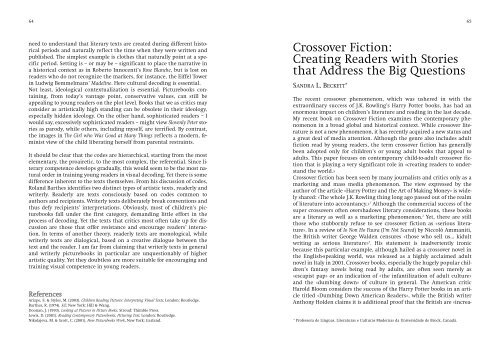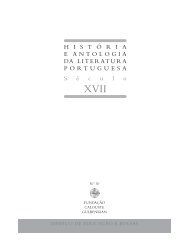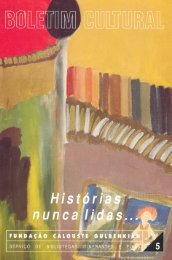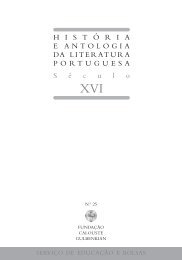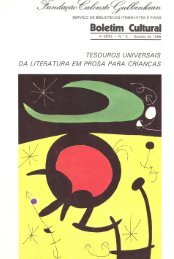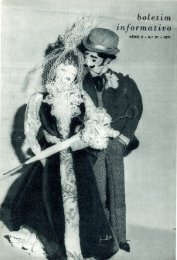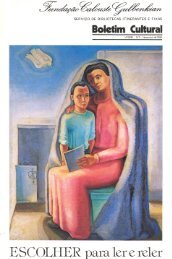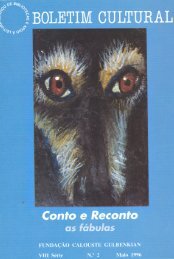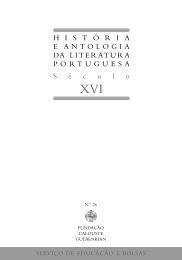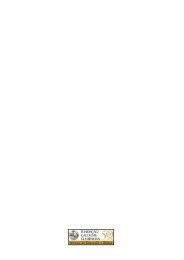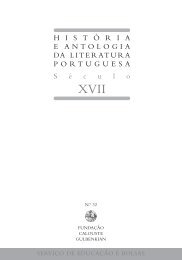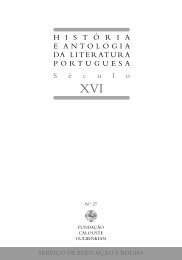Formar Leitores para Ler o Mundo - Leitura Gulbenkian - Fundação ...
Formar Leitores para Ler o Mundo - Leitura Gulbenkian - Fundação ...
Formar Leitores para Ler o Mundo - Leitura Gulbenkian - Fundação ...
Create successful ePaper yourself
Turn your PDF publications into a flip-book with our unique Google optimized e-Paper software.
64<br />
need to understand that literary texts are created during different historical<br />
periods and naturally reflect the time when they were written and<br />
published. The simplest example is clothes that naturally point at a specific<br />
period. Setting is – or may be – significant to place the narrative in<br />
a historical context as in Roberto Innocenti’s Rose Blanche, but is lost on<br />
readers who do not recognize the markers, for instance, the Eiffel Tower<br />
in Ludwig Bemmelmans’ Madeline. Here cultural decoding is essential.<br />
Not least, ideological contextualization is essential. Picturebooks containing,<br />
from today’s vantage point, conservative values, can still be<br />
appealing to young readers on the plot level. Books that we as critics may<br />
consider as artistically high standing can be obsolete in their ideology,<br />
especially hidden ideology. On the other hand, sophisticated readers – I<br />
would say, excessively sophisticated readers – might view Slovenly Peter stories<br />
as parody, while others, including myself, are terrified. By contrast,<br />
the images in The Girl who Was Good at Many Things reflects a modern, feminist<br />
view of the child liberating herself from parental restraints.<br />
It should be clear that the codes are hierarchical, starting from the most<br />
elementary, the proairetic, to the most complex, the referential. Since literary<br />
competence develops gradually, this would seem to be the most natural<br />
order in training young readers in visual decoding. Yet there is some<br />
difference inherent to the texts themselves. From his discussion of codes,<br />
Roland Barthes identifies two distinct types of artistic texts, readerly and<br />
writerly. Readerly are texts consciously based on codes common to<br />
authors and recipients. Writerly texts deliberately break conventions and<br />
thus defy recipients’ interpretations. Obviously, most of children’s picturebooks<br />
fall under the first category, demanding little effort in the<br />
process of decoding. Yet the texts that critics most often take up for discussion<br />
are those that offer resistance and encourage readers’ interaction.<br />
In terms of another theory, readerly texts are monological, while<br />
writerly texts are dialogical, based on a creative dialogue between the<br />
text and the reader. I am far from claiming that writerly texts in general<br />
and writerly picturebooks in particular are unquestionably of higher<br />
artistic quality. Yet they doubtless are more suitable for encouraging and<br />
training visual competence in young readers.<br />
Crossover Fiction:<br />
Creating Readers with Stories<br />
that Address the Big Questions<br />
SANDRA L. BECKETT*<br />
The recent crossover phenomenon, which was ushered in with the<br />
extraordinary success of J.K. Rowling’s Harry Potter books, has had an<br />
enormous impact on children’s literature and reading in the last decade.<br />
My recent book on Crossover Fiction examines the contemporary phenomenon<br />
in a broad global and historical context. While crossover literature<br />
is not a new phenomenon, it has recently acquired a new status and<br />
a great deal of media attention. Although the genre also includes adult<br />
fiction read by young readers, the term crossover fiction has generally<br />
been adopted only for children’s or young adult books that appeal to<br />
adults. This paper focuses on contemporary child-to-adult crossover fiction<br />
that is playing a very significant role in «creating readers to understand<br />
the world.»<br />
Crossover fiction has been seen by many journalists and critics only as a<br />
marketing and mass media phenomenon. The view expressed by the<br />
author of the article «Harry Potter and the Art of Making Money» is widely<br />
shared: «The whole J.K. Rowling thing long ago passed out of the realm<br />
of literature into accountancy.» 1 Although the commercial success of the<br />
super crossovers often overshadows literary considerations, these books<br />
are a literary as well as a marketing phenomenon. 2 Yet, there are still<br />
those who stubbornly refuse to see crossover fiction as «serious literature».<br />
In a review of Io Non Ho Paura (I’m Not Scared) by Niccolò Ammaniti,<br />
the British writer George Walden censures «those who sell us... kidult<br />
writing as serious literature» 3 . His statement is inadvertently ironic<br />
because this particular example, although hailed as a crossover novel in<br />
the English-speaking world, was released as a highly acclaimed adult<br />
novel in Italy in 2001. Crossover books, especially the hugely popular children’s<br />
fantasy novels being read by adults, are often seen merely as<br />
«escapist pap» or an indication of «the infantilization of adult culture»<br />
and the «dumbing down» of culture in general. The American critic<br />
Harold Bloom considers the success of the Harry Potter books in an article<br />
titled «Dumbing Down American Readers», while the British writer<br />
Anthony Holden claims it is additional proof that the British are «increa-<br />
References<br />
Arizpe, E. & Styles, M. (2003). Children Reading Pictures: Interpreting Visual Texts, London: Routledge.<br />
Barthes, R. (1974). S/Z, New York: Hill & Wang.<br />
Doonan, J. (1993). Looking at Pictures in Picture Books, Stroud: Thimble Press.<br />
Lewis, D. (2001). Reading Contemporary Picturebooks, Picturing Text, London: Routledge.<br />
Nikolajeva, M. & Scott, C. (2001). How Picturebooks Work, New York: Garland. * Professora de Línguas, Literaturas e Culturas Modernas da Universidade de Brock, Canadá.<br />
65


